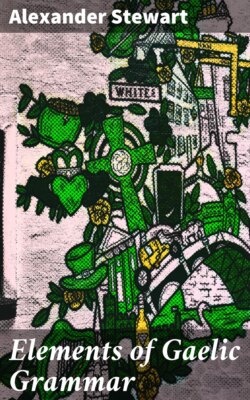Читать книгу Elements of Gaelic Grammar - Alexander Stewart - Страница 31
На сайте Литреса книга снята с продажи.
Uai.
ОглавлениеTable of Contents
1. Made up of (1) ua and (1) i; as, luaithe quicker.
2. Made up of (2) ua and (1) i; as, cruaidh hard, fuaim sound.
3. Like (1) ua; as, uair time, an hour, cluaise of an ear.
OF THE POWERS OF THE CONSONANTS.
The simple powers of the consonants differ not much from their powers in English. Those called mediae by the writers on Greek grammar, viz., b, d, g, approach nearer in force to the corresponding tenues p, t, c, than they do in English.
In accented syllables, where, if the vocal sound be short, the voice necessarily rests on the subsequent articulation, the consonants, though written single, are pronounced with the same degree of force as when written double in English; as, bradan a salmon, cos a foot; pronounced braddan, coss. No consonants are written double except l, n, r.
A propensity to aspiration is a conspicuous feature in the Gaelic tongue[10]. The aspirating of a consonant has been usually marked, in the Irish dialect, by a dot over the letter aspirated; in the Scottish dialect by writing h after it. All the consonants have their sounds changed by being aspirated, and the effect is different on different consonants. In some cases the articulation is changed, but still formed by the same organ. In others the articulation is formed by a different organ. In others the h alone retains its power. And sometimes both the h and the consonant to which it is subjoined become entirely quiescent.
In treating of the consonants separately, it will be convenient to depart a little from the alphabetical order of the letters, and to consider first the Labials, next the Palatals, and lastly the Linguals.
LABIALS.
